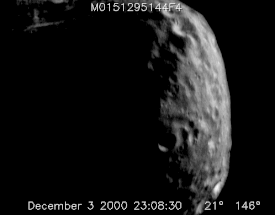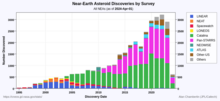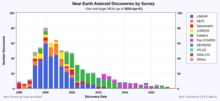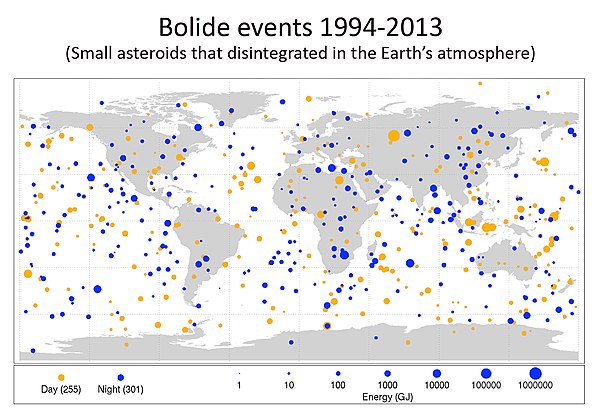Near-Earth object
| ||||||
A near-Earth object (NEO) is any small Solar System body whose orbit can bring it into proximity with Earth. By definition, a solar system body is a NEO if its closest approach to the Sun (perihelion) is less than 1.3 astronomical unit (AU).[2] If a NEO's orbit crosses that of the Earth's and the object is larger than 140 meters across, it is considered a Potentially hazardous object (PHO).[3] As of November 2017[update], all known PHOs are asteroids (PHAs).[1]
Known NEOs include more than seventeen thousand near-Earth asteroids (NEAs), more than one hundred near-Earth comets (NECs),[1] and a number of solar-orbiting spacecraft and meteoroids, large enough to be tracked in space before striking the Earth. It is now widely accepted that collisions in the past have had a significant role in shaping the geological and biological history of the Earth.[4] NEOs have become of increased interest since the 1980s because of increased awareness of the potential danger some of the asteroids or comets pose, and methods of mitigation are being researched.[5]
Based on the orbit calculations of NEOs, the risk of future impacts is assessed on two scales, the Torino scale and the more complex Palermo scale, both of which rate a risk of any significance with values above 0. Some NEOs have had positive initial Torino or Palermo scale ratings after their discovery, but as of November 2017[update], more precise calculations based on subsequent observations led to a reduction of the rating to or below 0 in all cases.[6]
The United States, European Union, and other nations are currently scanning for NEOs[7] in an effort called Spaceguard. In the United States and since 1998, NASA has a congressional mandate to catalogue all NEOs that are at least 1 kilometer (km) wide, as the impact of such an object would be globally catastrophic. In 2006, it was estimated that 20% of the mandated objects had not yet been found.[7] In 2011, largely as a result of the survey program NEOWISE, it was estimated that 93% of the NEAs larger than 1 km had been found and that only about 70 remained to be discovered.[8] As of November 14, 2017[update], 885 NEAs larger than 1 km have been discovered, of which 157 are potentially hazardous.[1] The inventory is much less complete for smaller objects, which still have potential for large scale, though not global, damage. To improve on that, NASA's Spaceguard mandate was extended in 2005 to objects at least 140 meters in diameter,[9] and since 2016, NASA's Planetary Defense Coordination Office aims to track NEOs larger than 30 to 50 meters in diameter.[10]
Due to their Earth-like orbits and low surface gravity, some NEOs can be approached by spacecraft with a relatively low energy (and thus fuel) expenditure.[11] Since the 1970s, both manned and unmanned missions have been proposed.[12] As of November 2017[update], three near-Earth asteroids have been visited by spacecraft,[5][13][14][15] and two more are en route for future rendezvous.[16][17] Plans to mine NEAs commercially have been picked up by a private company.[18]
Definitions
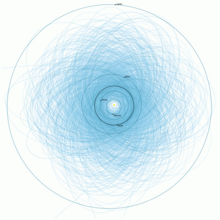
Near-Earth objects (NEOs) are small Solar System bodies with orbits around the Sun that lie partly between 0.983 and 1.3 astronomical units (AU; Sun–Earth distance) away from the Sun.[19] Thus, NEOs aren't objects that are currently near the Earth, but objects which can potentially approach the Earth at a relatively close distance.
When a NEO is detected, like all other small Solar System bodies, it is submitted to the International Astronomical Union's (IAU's) Minor Planet Center (MPC) for cataloging. MPC maintains separate lists of confirmed NEOs and potential NEOs.[20] Some NEOs' orbits intersect that of Earth's so they pose a collision danger.[3] The MPC maintains a separate list of these Potentially hazardous objects (PHOs).
PHOs are currently defined based on parameters that measure the object's potential to make threatening close approaches to the Earth.[2] Mostly objects with an Earth minimum orbit intersection distance (MOID) of 0.05 AU or less and an absolute magnitude of 22.0 or brighter (a rough indicator of large size) are considered PHOs. Objects that cannot approach closer to the Earth (i.e. MOID) than 0.05 AU (7,500,000 km; 4,600,000 mi), or are smaller than about 140 m (460 ft) in diameter (i.e. H = 22.0 with assumed albedo of 13%), are not considered PHOs.[2] NASA's catalog for near-Earth objects also includes the approach distances of asteroids and comets measured in lunar distances,[21] and this usage has become a common unit of measure used by the news media in discussing these objects.
History of human awareness of NEOs
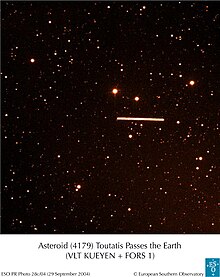
The first near-Earth objects to be observed by humans were comets. However, their extra-terrestrial nature was only recognised and confirmed after Tycho Brahe tried to measure the distance of a comet in 1577; and the periodicity of comets wasn't recognised until 1705, when Edmond Halley first published his orbit calculations for the returning object now known as Halley's Comet.[22] The 1758-1759 return of Halley's Comet was the first comet appearance predicted in advance.[23]
The first near-Earth asteroid to be discovered was 433 Eros in 1898.[24] The asteroid was subject to several observation campaigns, because it allowed for a precise determination of the distance of the Earth from the Sun.[25]
In 1937, asteroid 69230 Hermes was discovered when it passed the Earth at twice the distance of the Moon.[26] Hermes was considered a threat because it was lost after its discovery, thus its orbit and potential for collision with Earth wasn't known precisely.[27] Hermes was re-discovered in 2003.[26]
On June 14, 1968, 1.4-kilometer asteroid 1566 Icarus passed Earth at a distance of 0.042482 AU (6,355,200 km), or 16 times the distance of the Moon.[28] During this approach, Icarus became the first minor planet to be observed using radar, with measurements obtained at the Haystack Observatory[29] and the Goldstone Tracking Station.[30] This was the first close approach predicted years in advance (Icarus has been discovered in 1949), and also earned significant public attention, due to alarmist news reports.[27] A year before the approach, MIT students launched Project Icarus, devising a plan to deflect the asteroid with rockets in case it is found to be on a collision course with Earth.[31] Project Icarus received wide media coverage, and inspired the 1979 disaster movie Meteor, in which the USA and the USSR join forces to blow up an Earth-bound fragment of an asteroid hit by a comet.[32]
On March 23, 1989, the 300-meter (1,000-foot) diameter Apollo asteroid 4581 Asclepius (1989 FC) missed the Earth by 700,000 kilometers (430,000 mi). If the asteroid had impacted it would have created the largest explosion in recorded history, equivalent to 20,000 megaton TNT. It attracted widespread attention because it was discovered only after the closest approach.[33]
In March 1998, early orbit calculations for recently discovered asteroid (35396) 1997 XF11 showed a potential 2028 close approach 0.00031 AU (46,000 km) from the Earth, well within the orbit of the Moon, but with a large error margin allowing for a direct hit. Further data allowed a revision of the 2028 approach distance to 0.0064 AU (960,000 km), with no chance of collision. However, by that time, inaccurate reports of a potential impact caused a media storm.[27]
Risk

From the late 1990s, a typical frame of reference for looking at NEOs has been through the scientific concept of risk. In this frame, the risk that any near-Earth object poses is typically seen through a lens that is a function of both the culture and the technology of human society. Through history, humans have associated NEOs with changing risks, based on religious, philosophical or scientific views, as well as humanity's technological or economical capability to deal with risks.[34] Through history, NEOs have been seen as omens of natural disasters or wars, harmless spectacle in an unchanging universe, the source of era-changing cataclysms,[34] the source of potentially poisonous fumes (during Earth's passage through the tail of Halley's Comet in 1910),[35] and finally as the causes of crater-forming impacts that can even cause extinction.[34]
For near-Earth comets, the potential of catastrophic impacts was recognised as soon as orbit calculations have been made: in 1694, Edmond Halley presented a theory that Noah's flood in the Bible was caused by a comet impact.[36] Human perception of near-Earth asteroids as benign objects of fascination or killer objects with high risk to human society has ebbed and flowed in the short period of human history that NEAs have been scientifically observed.[12] The modern awareness of the threat of impacts that create craters much bigger than the impacting bodies and have indirect effects on an even wider area arose in the 1990s, after the confirmation of a theory that the Cretaceous–Paleogene extinction event (in which dinosaurs died out) 65 million years ago was caused by a large asteroid impact, and the observation of the impact of the fragments of Comet Shoemaker–Levy 9 into Jupiter in July 1994.[34]
Risk scales
There are two schemes for the scientific classification of impact hazards from NEOs:
- the simple Torino Scale, and
- the more complex Palermo Technical Impact Hazard Scale
The annual background frequency used in the Palermo scale for impacts of energy greater than E megatonnes is estimated as:[37]
For instance, this formula implies that the expected value of the time from now until the next impact greater than 1 megatonne is 33 years, and that when it occurs, there is a 50% chance that it will be above 2.4 megatonnes. This formula is only valid over a certain range of E.
However, another paper[38] published in 2002 – the same year as the paper on that the Palermo scale is based – found a power law with different constants:
This formula gives considerably lower rates for a given E. For instance, it gives the rate for bolides of 10 megatonnes or more (like the Tunguska explosion) as 1 per thousand years, rather than 1 per 210 years as in the Palermo formula. However, the authors give a rather large uncertainty (once in 400 to 1800 years for 10 megatonnes), due in part to uncertainties in determining the energies of the atmospheric impacts that they used in their determination.
Highly rated risks
NASA maintains a continuously updated Sentry Risk Table of the known NEO threats in the next 100 years.[6] All or nearly all of the objects are highly likely to eventually drop off the list as more observations come in, reducing the uncertainties and enabling more accurate orbital predictions.[6][39]

Asteroid (29075) 1950 DA was lost after its discovery in 1950, since its observations over just 17 days were insufficient to determine its orbit, and then rediscovered on December 31, 2000. It has a diameter of about a kilometer (0.6 miles). It was also observed by radar during its 2001 close approach, allowing for more precise orbit calculations. Although it will not strike for at least 800 years and thus has no Torino scale rating, (29075) 1950 DA was added to the list in April 2002 because it was the first object with a Palermo scale value greater than zero.[5][40] The then calculated 1 in 300 maximum chance of impact and +0.17 Palermo scale value was roughly 50% greater than the background risk of impact by similarly large objects until 2880.[41] Uncertainties in the orbit calculations were further reduced using radar observations in 2012.[42] Also taking optical observations up until 2015 into account, as of November 2017[update], the probability of impact is assessed at 1 in 8,300,[43] however, the corresponding Palermo scale value of −1.42 is still the highest for all objects on the Sentry List Table.[6] As of November 2017[update], only two more objects (2010 GZ60 and (410777) 2009 FD) have Palermo scale values above −2 for a single impact date.[6]
In July 2002, (89959) 2002 NT7 became the first asteroid with a positive rating on the Torino Scale, with an approximately one in a million chance on a potential impact date of approximately February 1, 2019.[44] After more observations, the estimated risk was reduced to zero, and the asteroid was removed from the Sentry Risk Table in August 2002.[45] It is now known that 2002 NT7 will actually safely pass 0.4078 AU (61,010,000 km; 37,910,000 mi) from the Earth on January 13, 2019.[46]
On December 24, 2004, minor planet 99942 Apophis (at the time known by its provisional designation 2004 MN4) was assigned a 4 on the Torino scale, the highest rating ever achieved, as there was a 2.7% chance of Earth impact on April 13, 2029. By December 28, 2004, additional observations had produced a smaller uncertainty zone which no longer included the Earth during the 2029 approach. The 2029 risk of impact consequently dropped to zero, but later potential impact solutions were still rated 1 on the Torino scale. The 2036 risk was lowered to a Torino rating of 0 in August 2006. As of November 2017[update], calculations show Apophis has no chance of impacting Earth before 2060.[6]
In February 2006, (144898) 2004 VD17 has been assigned a Torino Scale rating of 2 due to a close encounter predicted for May 4, 2102.[47] After more precise calculations, the rating was lowered to 1 in May 2006 and 0 in October 2006, and the asteroid was removed from the Sentry Risk Table entirely in February 2008.[45]
As of November 2017[update], 2010 RF12 is listed with the highest chance of impacting Earth, at 1 in 20 on September 5, 2095. However, at only 7 meters across, the asteroid doesn't pose a serious threat: the possible 2095 impact rates only −3.32 on the Palermo Scale.[48]
Projects to minimize the threat
The first astronomical program dedicated to the discovery of near-Earth asteroids was the Palomar Planet-Crossing Asteroid Survey, started in 1973 by astronomers Eugene Shoemaker and Eleanor Helin.[12]
In 1998, the United States Congress mandated the Spaceguard Survey – detection of 90% of near-earth asteroids over 1 km diameter (that threaten global devastation) by 2008. Several surveys have undertaken "Spaceguard" activities (an umbrella term), including Lincoln Near-Earth Asteroid Research (LINEAR), Spacewatch, Near-Earth Asteroid Tracking (NEAT), Lowell Observatory Near-Earth-Object Search (LONEOS), Catalina Sky Survey (CSS), Campo Imperatore Near-Earth Object Survey (CINEOS), Japanese Spaceguard Association, Asiago-DLR Asteroid Survey (ADAS) and Near-Earth Object WISE (NEOWISE). In 2011, it was estimated that 93% of near-Earth asteroids larger than 1 km in diameter have been found, thus the original Spaceguard goal has been met.[8][49]
In 2005, in the USA, the original Spaceguard mandate was extended by the George E. Brown, Jr. Near-Earth Object Survey Act, which calls for NASA to detect 90% of NEOs with diameters of 140 meters or greater, by 2020.[9] In January 2016, NASA announced the Planetary Defense Coordination Office to track NEOs larger than 30 to 50 meters in diameter and coordinate an effective threat response and mitigation effort.[10]
In May 2016, the precision of asteroid diameter estimates arising from the Wide-field Infrared Survey Explorer and NEOWISE missions have been questioned by technologist Nathan Myhrvold,[50][51][52] but the criticism has not passed peer review as of August 2017[53] and faced criticism for its methodology itself.[54]
Survey programs aim to identify threats years in advance, giving humanity time to prepare a space mission to avert the threat.
REP. STEWART: ... are we technologically capable of launching something that could intercept [an asteroid]? ... DR. A'HEARN: No. If we had spacecraft plans on the books already, that would take a year ... I mean a typical small mission ... takes four years from approval to start to launch ...
The ATLAS project, by contrast, aims to find impacting asteroids shortly before impact, much too late for deflection maneuvers but still in time to evacuate and otherwise prepare the affected Earth region.[56]
Number and classification


Near-Earth objects are classified as meteoroids, asteroids, or comets depending on size and composition. Asteroids can also be members of an asteroid family, and comets create meteoroid streams that can generate meteor showers.
As of November 14, 2017[update], 17,155 NEOs have been discovered:[1] 106 near-Earth comets and 17,049 near-Earth asteroids. There are 1,859 NEOs that are classified as potentially hazardous asteroids (PHAs). 157 known PHAs and 885 known NEAs are estimated to measure least 1 kilometer (km) in diameter (roughly corresponds to an absolute magnitude of 17.75 or brighter); and 7,903 known NEAs are larger than about 140 meters in diameter.[1]
As of November 14, 2017[update], there are 792 NEAs on the Sentry impact risk page at the NASA website.[6] A significant number of these NEAs are equal to or smaller than 50 meters in diameter and none of the listed objects are placed even in the "green zone" (Torino Scale 1), meaning that none warrant the attention of general public.[57] As of November 14, 2017[update], the JPL Small-Body Database lists 3,714 near-Earth asteroids with an absolute magnitude dimmer than 25 (roughly 50 meters in diameter).[58]
Near-Earth asteroids smaller than ~1 meter are near-Earth meteoroids and are listed as asteroids on most asteroid tables. The smallest known near-Earth meteoroid is 2008 TS26 with an absolute magnitude of 33.2[58] and estimated size of only 1 meter.[59]
Near-Earth asteroids
These are objects in a near-Earth orbit without the tail or coma of a comet. As of November 14, 2017[update], 17,049 near-Earth asteroids are known,[1] ranging in size from 1 meter up to ~32 kilometers (1036 Ganymed). The estimated number of possibly existing near-Earth asteroids over one kilometer in diameter was reduced by NASA from 1,000–2,000 to 500–1,000 in 2000.[60][61] An alternative estimate based on the LINEAR survey provided the number 1227+170
−90.[62] In 2011, the NASA estimate of one-kilometer NEAs was narrowed to 981±19 (of which 93% have been discovered), while the number of NEAs larger than 140 meters across was estimated at 13200±1900.[8][49] In 2017, two studies further reduced the estimated number of NEAs over one kilometer in diameter to 921±20.[63] There are about 1 million near-Earth asteroids about 40 meters in diameter—of which about 1 percent have been discovered by 2015.[64] The composition of near-Earth asteroids is comparable to that of asteroids from the asteroid belt, reflecting a variety of asteroid spectral types.[65]
NEAs survive in their orbits for just a few million years.[19] They are eventually eliminated by planetary perturbations, causing ejection from the Solar System or a collision with the Sun or a planet. With orbital lifetimes short compared to the age of the Solar System, new asteroids must be constantly moved into near-Earth orbits to explain the observed asteroids. The accepted origin of these asteroids is that asteroid-belt asteroids are moved into the inner Solar System through orbital resonances with Jupiter. The interaction with Jupiter through the resonance perturbs the asteroid's orbit and it comes into the inner Solar System. The asteroid belt has gaps, known as Kirkwood gaps, where these resonances occur as the asteroids in these resonances have been moved onto other orbits. New asteroids migrate into these resonances, due to the Yarkovsky effect that provides a continuing supply of near-Earth asteroids.[66]
A small number of NEAs are extinct comets that have lost their volatile surface materials, although having a faint or intermittent comet-like tail does not necessarily result in a classification as a near-Earth comet, making the boundaries somewhat fuzzy. The rest of the near-Earth asteroids are driven out of the asteroid belt by gravitational interactions with Jupiter.[19][67]
Orbital classification of NEAs

Near-Earth asteroids are divided into groups based on their semi-major axis (a), perihelion distance (q), and aphelion distance (Q):[2][19]
- The Atiras or Apohele asteroids have orbits strictly inside Earth's orbit: an Atira asteroid's aphelion distance (Q) is smaller than Earth's perihelion distance (0.983 AU). That is, Q < 0.983 AU. (This implies that the asteroid's semi-major axis is also less than 0.983 AU.)
- The Atens have a semi-major axis of less than 1 AU and cross Earth's orbit. Mathematically, a < 1.0 AU and Q > 0.983 AU.
- The Apollos have a semi-major axis of more than 1 AU and cross Earth's orbit. Mathematically, a > 1.0 AU and q < 1.017 AU. (1.017 AU is Earth's aphelion distance.)
- The Amors have orbits strictly outside Earth's orbit: an Amor asteroid's perihelion distance (q) is greater than Earth's aphelion distance (1.017 AU). Amor asteroids are also near-earth objects so q < 1.3 AU. In summary, 1.017 AU < q < 1.3 AU. (This implies that the asteroid's semi-major axis (a) is also larger than 1.017 AU.) Some Amor asteroid orbits cross the orbit of Mars.
(Note: Some authors define the Atens group differently: they define it as being all the asteroids with a semi-major axis of less than 1 AU. That is, they consider the Atiras to be part of the Atens. Historically, until 1998, there were no known or suspected Atiras, so the distinction wasn't necessary.)
Atiras and Amors do not cross the Earth's orbit and are not immediate impact threats, but their orbits may change to become Earth-crossing orbits in the future.
As of November 14, 2017[update], 1,251 Aten asteroids, 9,282 Apollo asteroids and 6,500 Amor asteroids have been discovered and catalogued.[1]
Co-orbital NEAs

NEAs on a co-orbital configuration have the same orbital period as the Earth. All co-orbital asteroids have special orbits that are relatively stable and, paradoxically, can prevent them from getting close to Earth:
- Trojans: Near the orbit of a planet, there are fivegravitational equilibrum points, the Lagrangian points, in which an asteroid would orbit the Sun in fixed formation with the planet. Two of these, 60 degrees ahead respectively behind the planet along its orbit (designated L4 and L5) are stable, that is, an asteroid near these points would stay there for millions of years even if perturbed by other planets and non-gravitational forces. As of November 2017[update] Earth's only confirmed Trojan is 2010 TK7, circling Earth's L4 point.[68]
- Asteroids in a horseshoe orbit: The region of stability around L4 and L5 also includes orbits for co-orbital asteroids that run around both L4 and L5. Seen from the Earth, the orbit can resemble the circumference of a horseshoe, or may consist of annual loops that wander back and forth (librate) in a horseshoe-shaped area. In both cases, the Sun is at the horseshoe's center of gravity, Earth is in the gap of the horseshoe, and L4 and L5 are inside the ends of the horseshoe. A number of NEAs in horseshoe orbits have been discovered. The most-studied and largest is 3753 Cruithne, which travels along bean-shaped annual loops and completes its horseshoe libration cycle every 770 to 780 years.[69][70] (419624) 2010 SO16 is an asteroid on a relatively stable circumference-of-a-horseshoe orbit, with a horseshoe libration period of about 350 years.[71]
- Quasi-satellites: Quasi-satellites are co-orbital asteroids on a normal elliptic orbit with a higher eccentricity than the Earth's, which they travel in a way synchronised with Earth's. Since the asteroid orbits the Sun slower than the Earth when further away and faster than Earh when closer to the Sun, when observed from Earth, the quasi-satellite appears to orbit Earth in a retrograde direction, even though it is not bound gravitationally. A number of asteroids are or have been known to be a quasi-satellite of Earth. (469219) 2016 HO3 is Earth's closest quasi-satellite, in an orbit that has been stable for almost a century.[72] Asteroids can repeatedly transfer between horseshoe and quasi-satellite orbits. For example, 2003 YN107 transferred from a quasi-satellite orbit to a horseshoe orbit in 2006, and is expected to transfer back to a quasi-satellite orbit 60 years later.[73]
- Temporary satellites: NEAs can also transfer between solar orbits and distant Earth orbits, becoming gravitationally bound temporary satellites. As of November 2017[update], the only confirmed transition was that of asteroid 2006 RH120, which was a temporary satellite from September 2006 to June 2007[74][75] and a 1.003-year solar orbit ever since.[76] According to orbital calculations, on its solar orbit, 2006 RH120 passes Earth at low speed every 20 to 21 years,[76] at which point it can become a temporary satellite again.
Near-Earth comets
As of November 14, 2017[update], 106 near-Earth comets (NECs) have been discovered.[1] Although no impact of a comet in Earth's history has been conclusively confirmed, the Tunguska event may have been caused by a fragment of Comet Encke.[77] Cometary fragmenting may also be responsible for some impacts from near-Earth objects.
It is rare for a comet to pass within 0.1 AU (15,000,000 km; 9,300,000 mi) of Earth. As of November 2017[update], the closest recorded approach was 0.0151 AU (5.88 LD) for Lexell's Comet on July 1, 1770.[78] Comet 109P/Swift–Tuttle, which is also the source of the Perseid meteor shower which hits Earth every year in August, has a roughly 130-year orbit which passes close to the Earth. After the comet's 1992 return, when only the two previous returns in 1862 and 1737 have been identified, orbital calculations showed that the comet would pass very close to Earth during its next return in 2126, with an impact within the range of uncertainty. By 1993, even earlier returns (back to at least 188 AD) have been identified, and the new orbital calculation eliminated the impact risk, predicting the comet to pass Earth at a distance of 24 million kilometers. However, in 3044, the comet is expected to pass Earth at less than 1.6 million kilometers.[79]
Only short-period comets (which have an orbital period of less than 200 years) are considered NECs.[2] These near-Earth objects were probably derived from the Kuiper belt, beyond the orbit of Neptune. Comets with longer periods are unlikely to have been observed during multiple returns and thus their orbits, close approaches and potential impacts can't be calculated in advance reliably.
Artificial near-Earth objects

Defunct space probes and final stages of rockets can end up in near-Earth orbits around the Sun, and be re-discovered by NEO surveys when they return to Earth's vicinity.
In September 2002, astronomers found an object designated J002E3. The object was on a temporary satellite orbit around Earth, leaving for a solar orbit in June 2003. Calculations showed that it was also on a solar orbit before 2002, but was close to Earth in 1971. J002E3 was identified as the third stage of the Saturn V rocket that carried Apollo 12 to the Moon.[80][81] In 2006, two more apparent temporary satellites were discovered which were suspected of being artificial.[81] One of them was eventually confirmed as an asteroid and classified as the temporary satellite2006 RH120.[81] The other, 6Q0B44E, was confirmed as an artificial object, but its identity is unknown.[81] Another confirmed artificial temporary satellite with unidentified origin is 2013 QW1.[81]
In some cases, active space probes on solar orbits have been observed by NEO surveys and catalogued as asteroids before identification: during its 2007 flyby of Earth, space probe Rosetta was detected unidentified and classified as asteroid 2007 VN84, with an alert issued due to its close approach;[82] while the designation 2015 HP116 was removed from asteroid catalogues when the observed object was identified with ESA space observatory Gaia.[83]
Impacts
Stony asteroids with a diameter of 4 meters (13 ft) impact Earth approximately once per year.[84] Asteroids with a diameter of roughly 7 meters enter Earth's atmosphere with as much energy as Little Boy (the atomic bomb dropped on Hiroshima, approximately 15 kilotonnes of TNT) about every 5 years.[84] These ordinarily explode in the upper atmosphere, and most or all of the solids are vaporized.[85] Every 2,000–3,000 years, objects produce explosions of 10 megatons comparable to the one observed at Tunguska in 1908.[86] Objects with a diameter of one kilometer hit the Earth an average of twice every million years.[19] Large collisions with five kilometer objects happen approximately once every twenty million years.[84]
Assuming that these rates will continue for the next billion years, there exist at least 2,000 objects of diameter greater than 1 km that will eventually hit Earth. However, most of these are not yet considered potentially hazardous objects because they are currently orbiting between Mars and Jupiter. Eventually they will change orbits and become NEOs. Objects spend on average a few million years as NEOs before hitting the Sun, being ejected from the Solar System, or (for a small proportion) hitting a planet.[19]
The second-largest observed impact after the Tunguska meteor was a 1.1-megaton air blast near the Prince Edward Islands off the coast of South Africa in 1963, which was only detected by infrasound sensors.[87] The third-largest but most-observed impact was the Chelyabinsk meteor of February 15, 2013. A 20-meter asteroid exploded with the equivalent blast yield of 400–500 kilotons.[87] The calculated orbit of the pre-impact asteroid is similar to that of Apollo asteroid 2011 EO40, making the latter the meteor's possible parent body.[88]
Close approaches
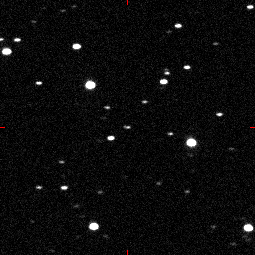
Each year, several NEOs pass Earth closer than the distance of the Moon.[89]
On August 10, 1972, a meteor that became known as 1972 Great Daylight Fireball was witnessed by many people moving north over the Rocky Mountains from the U.S. Southwest to Canada. It was an Earth-grazing meteoroid that passed within 57 kilometers (about 34 miles) of the Earth's surface. It was filmed by a tourist at the Grand Teton National Park in Wyoming with an 8-millimeter color movie camera.[90]
On October 13, 1990, an Earth-grazing meteoroid EN131090 was observed above Czechoslovakia and Poland. It was moving with a speed of 41.74 km/s (25.94 mi/s) along a 409 km (254 mi) trajectory from the south to the north. The closest approach to the Earth was 98.67 km (61.31 mi). It was captured by two all-sky cameras of the European Fireball Network, which for the first time enabled geometric calculations of the orbit of such a body.[91]
On March 18, 2004, LINEAR announced a 30-meter asteroid, 2004 FH, which would pass the Earth that day at only 42,600 km (26,500 mi), about one-tenth the distance to the Moon, and the closest miss ever noticed by that time. They estimated that similar-sized asteroids come as close about every two years.[92]
On March 31, 2004, two weeks after 2004 FH, meteoroid 2004 FU162 set a new record for closest recorded approach above the atmosphere, passing Earth's surface only 6,500 km (4,000 mi) away (about one Earth radius or one-sixtieth of the distance to the Moon). Because it was very small (6 meters/20 feet), FU162 was detected only hours before its closest approach. If it had collided with Earth, it probably would have harmlessly disintegrated in the atmosphere.[93]
On October 7, 2008, 19 hours after it has been first observed, asteroid 2008 TC3 blew up 37 kilometers (23 mi) above the Nubian Desert in Sudan. It was the first time that an asteroid impact had been predicted prior to its entry into the atmosphere as a meteor.[94]
On February 4, 2011, an asteroid designated 2011 CQ1, estimated at 0.8–2.6 m (2.6–8.5 ft) in diameter, passed within 5,500 km (3,400 mi) of the Earth, setting a new record for closest approach without impact,[95] which still stands as of November 2017[update].[89]
On November 8, 2011, (308635) 2005 YU55 (relatively large at about 360 m in diameter) passed within 324,600 km (201,700 mi) (0.85 lunar distances) of Earth.[96]
On February 15, 2013, the 30-meter asteroid 367943 Duende (2012 DA14) passed approximately 27,700 km (17,200 mi) above the surface of Earth. This was closer than satellites in geosynchronous orbit. The asteroid was not visible to the unaided eye. This was the first close passage of an object already discovered during a previous passage, and was thus the first to be predicted in advance.[97]
On January 2, 2014, just 21 hours after it was the first asteroid to be discovered in 2014, 2014 AA blew up in Earth's atmosphere above the Atlantic Ocean. Far from any land, the meteor explosion was only observed by three infra-sound detectors of the Comprehensive Nuclear-Test-Ban Treaty Organization. This impact was the second to be predicted in advance.[98]
Exploratory missions
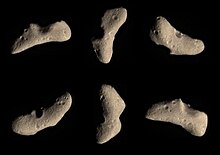

Some NEOs are of special interest because they can be physically explored with lower mission velocity than for even the Moon, due to their combination of low velocity with respect to Earth and weak gravity, so they may present interesting scientific opportunities both for direct geochemical and astronomical investigation, and as potentially economical sources of extraterrestrial materials for human exploitation.[11] This makes them an attractive target for exploration.[99]
The International Astronomical Union held a minor planets workshop in Tucson, Arizona in March 1971. At that point, launching a spacecraft to asteroids was considered premature, the workshop only inspired the first astronomical survey specifically aiming for NEAs.[12] Missions to asteroids were considered again during a workshop at the University of Chicago held by NASA’s Office of Space Science in January 1978. Of all of the near-Earth asteroids (NEA) that had been discovered by mid-1977, it was estimated that spacecraft could rendezvous with and return from only about one in 10 using less propulsive energy than is necessary to reach Mars. However, it was recognised that due to the low surface gravity of all NEAs, moving around on the surface of a NEA would cost very little energy, thus space probes could gather multiple samples.[12] Overall, it was estimated that about one percent of all NEAs might provide opportunities for human-crewed missions, or no more than about ten NEAs known at the time. A five-fold increase in the NEA discovery rate was deemed necessary to make a manned mission within ten years worthwhile.[12]
The first near-Earth object to be visited by a spacecraft was 17-kilometer asteroid 433 Eros when NASA's Near Earth Asteroid Rendezvous (NEAR) probe orbited it from February 2001 until landing on the asteroid surface in February 2002.[13] A second near-Earth asteroid, the 535-meter-long peanut-shaped 25143 Itokawa, was visited in September 2005 by the JAXA Hayabusa mission,[14] which succeeded in taking material samples back to Earth. A third near-Earth asteroid, 4179 Toutatis, was explored by CNSA's Chang'e 2 spacecraft during a flyby in December 2012.[5][15]
The one-kilometer Apollo asteroid 162173 Ryugu is the target of the JAXA Hayabusa 2 mission. The space probe was launched in December 2014, is expected to arrive at the asteroid in June 2018 and return a sample to Earth in December 2020.[16] The 500-meter Apollo asteroid 101955 Bennu, which, as of November 2017[update], has the third-highest cumulative Palermo scale rating (−1.71 for several close encounters between 2175 and 2199),[6] is the target of NASA's OSIRIS-REx probe. The New Frontiers program mission was launched in September 2016.[17] On its two-year journey to Bennu, the probe is searching for Earth's Trojan asteroids.[100] will rendezvous with Bennu in August 2018, and will return samples from the asteroid in September 2023.[17]
In April 2012, the company Planetary Resources announced its plans to mine asteroids commercially. In a first phase, the company reviewed data and selected potential targets among NEAs. In a second phase, space probes would be sent to the selected NEAs; and mining spacecraft would be sent in a third phase.[18] In April 2015, Planetary Resources launched a testbed satellite, a second is scheduled to launch in December 2017, and the first prospecting satellite for the second phase is planned for a 2020 launch.[101]
See also
References
- ^ a b c d e f g h i "Near-Earth Asteroid Discovery Statistics". NASA/JPL CNEOS. November 12, 2017. Retrieved 2017-11-14.
- ^ a b c d e "NEO Basics. NEO Groups". NASA/JPL CNEOS. Retrieved 2017-11-09.
- ^ a b Clark R. Chapman (May 2004). "The hazard of near-Earth asteroid impacts on earth". Earth and Planetary Science Letters. 222 (1): 1–15. Bibcode:2004E&PSL.222....1C. doi:10.1016/j.epsl.2004.03.004.
- ^ Richard Monastersky (March 1, 1997). "The Call of Catastrophes". Science News Online. Archived from the original on 2004-03-13. Retrieved 2017-11-09.
- ^ a b c d "The IAU and Near Earth Objects". Retrieved 2017-11-09.
- ^ a b c d e f g h "Sentry Risk Table". NASA/JPL CNEOS. Retrieved 2017-11-14.
- ^ a b Shiga, David (June 27, 2006). "New telescope will hunt dangerous asteroids". New Scientist. Retrieved 2017-11-09.
- ^ a b c "WISE Revises Numbers of Asteroids Near Earth". NASA/JPL. September 29, 2011. Retrieved 2017-11-09.
- ^ a b "Public Law 109–155–DEC.30, 2005" (PDF). Retrieved 2017-11-09.
- ^ a b Graham Templeton (January 12, 2016). "NASA is opening a new office for planetary defense". ExtremeTech. Retrieved 2017-11-10.
- ^ a b Dan Vergano (February 2, 2007). "Near-Earth asteroids could be 'steppingstones to Mars'". USA Today. Retrieved 2017-11-18.
- ^ a b c d e f Portree, David S. (March 23, 2013). "Earth-Approaching Asteroids as Targets for Exploration (1978)". Wired. Retrieved 2017-11-09.
People in the early 21st century have been encouraged to see asteroids as the interplanetary equivalent of sea monsters. We often hear talk of "killer asteroids," when in fact there exists no conclusive evidence that any asteroid has killed anyone in all of human history. … In the 1970s, asteroids had yet to gain their present fearsome reputation … most astronomers and planetary scientists who made a career of studying asteroids rightfully saw them as sources of fascination, not of worry.
- ^ a b Donald Savage; Michael Buckley (January 31, 2001). "NEAR Mission Completes Main Task, Now Will Go Where No Spacecraft Has Gone Before". Press Releases. NASA. Retrieved 2017-11-09.
{{cite news}}: Unknown parameter|last-author-amp=ignored (|name-list-style=suggested) (help) - ^ a b Don Yeomans (August 11, 2005). "Hayabusa's Contributions Toward Understanding the Earth's Neighborhood". NASA/JPL Near Earth Object Program. Archived from the original on 2005-09-05. Retrieved 2017-11-07.
- ^ a b Emily Lakdawalla (December 14, 2012). "Chang'e 2 imaging of Toutatis". Blog. The Planetary Society. Retrieved 2017-11-10.
- ^ a b Stephen Clark (December 3, 2014). "Hayabusa 2 launches on audacious asteroid adventure". Spaceflight Now. Retrieved 2017-11-14.
- ^ a b c Wall, Mike (September 9, 2016). "'Exactly Perfect'! NASA Hails Asteroid Sample-Return Mission's Launch". Space.com. Retrieved 2017-11-14.
- ^ a b Kelly Beatty (April 24, 2012). "Asteroid Mining for Fun and Profit". Sky & Telescope. Retrieved 2017-11-18.
- ^ a b c d e f Morbidelli, Alessandro; Bottke Jr., William F.; Froeschlé, Christiane; Michel, Patrick (January 2002). W. F. Bottke Jr.; A. Cellino; P. Paolicchi; R. P. Binzel (eds.). "Origin and Evolution of Near-Earth Objects" (PDF). Asteroids III. University of Arizona Press: 409–422. Bibcode:2002aste.book..409M. Retrieved 2017-11-09.
- ^ "The NEO Confirmation Page". Minor Planet Center. Retrieved 2017-11-09.
- ^ "NEO Earth Close Approaches". NASA/JPL CNEOS. Retrieved 2017-11-09.
- ^ Halley, Edmund (1705). A synopsis of the astronomy of comets. London: John Senex.
- ^ Stoyan, Ronald (2015). Atlas of Great Comets. Cambridge: Cambridge University Press. pp. 101–103. Retrieved 2017-11-16.
- ^ Scholl, Hans; Schmadel, Lutz D. (2002). "Discovery Circumstances of the First Near-Earth Asteroid (433) Eros". Acta Historica Astronomiae. 15: 210–220. Bibcode:2002AcHA...15..210S.
- ^ "Eros comes on stage, finally a useful asteroid". Johns Hopkins University Applied Physics Laboratory. Retrieved 2017-11-14.
- ^ a b "Radar observations of long-lost asteroid 1937 UB (Hermes)". Cornell University, Arecibo Observatory. Retrieved 2017-11-14.
- ^ a b c Brian G. Marsden (March 29, 1998). "How the Asteroid Story Hit: An Astronomer Reveals How a Discovery Spun Out of Control". Boston Globe. Retrieved 2017-11-14.
- ^ "1566 Icarus (1949 MA). Close-Approach Data". NASA/JPL. June 13, 2017. Retrieved 2017-11-10.
- ^ Pettengill, G. H.; Shapiro, I. I.; Ash, M. E.; Ingalls, R. P.; Rainville, L. P.; Smith, W. B.; et al. (May 1969). "Radar observations of Icarus". Icarus. 10 (3): 432–435. Bibcode:1969Icar...10..432P. doi:10.1016/0019-1035(69)90101-8. ISSN 0019-1035.
- ^ Goldstein, R. M. (November 1968). "Radar Observations of Icarus". Science. 162 (3856): 903–904(SciHomepage). Bibcode:1968Sci...162..903G. doi:10.1126/science.162.3856.903. PMID 17769079.
- ^ Dwayne A. Day (July 5, 2004). "Giant bombs on giant rockets: Project Icarus". The Space Review. Retrieved 2017-11-14.
- ^ "MIT Course precept for movie" (PDF). The Tech. MIT. October 30, 1979. Retrieved 2017-11-15.
- ^ Warren E. Leary (April 20, 1989). "Big Asteroid Passes Near Earth Unseen In a Rare Close Call". The New York Times. Retrieved 2017-11-14.
- ^ a b c d Fernández Carril, Luis (May 14, 2012). "The evolution of near Earth objects risk perception". The Space Review. Retrieved 2017-11-15.
- ^ Stuart Clark (December 20, 2012). "Apocalypse postponed: how Earth survived Halley's comet in 1910". The Guardian. Retrieved 2017-11-18.
- ^ Jason Colavito. "Noah's Comet. Edmond Halley 1694". Retrieved 2017-11-16.
- ^ "Palermo Technical Impact Hazard Scale". NASA/JPL CNEOS. Retrieved 2017-11-09.
- ^ P. Brown; et al. (November 2002). "The flux of small near-Earth objects colliding with the Earth". Nature. 420: 294–296.
{{cite journal}}: Explicit use of et al. in:|author=(help) - ^ David Chandler (May 2, 2006). "Big new asteroid has slim chance of hitting Earth". New Scientist. Retrieved 2017-11-10.
- ^ "Asteroid 1950 DA". NASA/JPL CNEOS. Retrieved 2017-11-09.
- ^ Giorgini, J. D.; Ostro, S. J.; Benner, L. A. M.; Chodas, P. W.; Chesley, S. R.; Hudson, R. S.; Nolan, M. C.; Klemola, A. R.; et al. (April 5, 2002). "Asteroid 1950 DA's Encounter with Earth in 2880: Physical Limits of Collision Probability Prediction" (PDF). Science. 296 (5565): 132–136. Bibcode:2002Sci...296..132G. doi:10.1126/science.1068191. PMID 11935024. Retrieved 2017-11-09.
- ^ Farnocchia, Davide; Chesley, Steven R. (2013). "Assessment of the 2880 impact threat from asteroid (29075) 1950 DA". Icarus. 229: 321–327. arXiv:1310.0861. Bibcode:2014Icar..229..321F. doi:10.1016/j.icarus.2013.09.022.
- ^ "29075 (1950 DA) Earth Impact Risk Summary". NASA/JPL CNEOS. April 8, 2017. Retrieved 2017-11-14.
- ^ A. J. S. Rayl (July 25, 2002). "Asteroid 2002 NT7 Under Watch, But Probably Not Coming Our Way". Planetary News. The Planetary Society. Archived from the original on 2006-04-05. Retrieved 2017-11-10.
{{cite news}}: Unknown parameter|deadurl=ignored (|url-status=suggested) (help) - ^ a b "Date/Time Removed". NASA/JPL CNEOS. Retrieved 2017-11-14.
- ^ "89959 (2002 NT7). Close-Approach Data". NASA/JPL. June 23, 2017. Retrieved 2017-11-10.
- ^ David Morrison (March 1, 2006). "Asteroid 2004 VD17 classed as Torino Scale 2". Asteroid and Comet Impact Hazards. NASA. Archived from the original on 2011-10-14. Retrieved 2017-11-10.
{{cite news}}: Unknown parameter|deadurl=ignored (|url-status=suggested) (help) - ^ "Impact Risk Summary: 2010 RF12". NASA/JPL CNEOS. April 8, 2017. Retrieved 2017-11-14.
- ^ a b A. Mainzer; T. Grav; J. Bauer; J. Masiero; R. S. McMillan; R. M. Cutri; R. Walker; E. Wright; P. Eisenhardt; D. J. Tholen; T. Spahr; R. Jedicke; L. Denneau; E. DeBaun; D. Elsbury; T. Gautier; S. Gomillion; E. Hand; W. Mo; J. Watkins; A. Wilkins; G. L. Bryngelson; A. Del Pino Molina; S. Desai; M. Go'mez Camus; S. L. Hidalgo; I. Konstantopoulos; J. A. Larsen; C. Maleszewski; M. A. Malkan; J.-C. Mauduit; B. L. Mullan; E. W. Olszewski; J. Pforr; A. Saro; J. V. Scotti; L. H. Wasserman (December 20, 2011). "NEOWISE Observations of Near-Earth Objects: Preliminary Results". The Astrophysical Journal. 743 (2): 156. arXiv:1109.6400. Bibcode:2011ApJ...743..156M. doi:10.1088/0004-637X/743/2/156.
- ^ Chang, Kenneth (May 23, 2016). "How Big Are Those Killer Asteroids? A Critic Says NASA Doesn't Know". New York Times. Retrieved 2017-11-09.
- ^ Myhrvold, Nathan (May 23, 2016). "Asteroid thermal modeling in the presence of reflected sunlight with an application to WISE/NEOWISE observational data" (Document). Bibcode:2016arXiv160506490M.
{{cite document}}: Cite document requires|publisher=(help); Unknown parameter|arxiv=ignored (help) - ^ Billings, Lee (May 27, 2016). "For Asteroid-Hunting Astronomers, Nathan Myhrvold Says the Sky Is Falling". Scientific American. Retrieved 2017-11-09.
- ^ NASA Content Administrator (May 25, 2016). "NASA Response to Recent Paper on NEOWISE Asteroid Size Results". News. NASA. Retrieved 2017-11-10.
- ^ Phil Plait (May 27, 2016). "A Physics Outsider Says NASA Asteroid Scientists Are All Wrong. Is He Right? (Spoiler: No)". Slate. Retrieved 2017-11-09.
- ^ U.S.Congress (March 19, 2013). "Threats From Space: a Review of U.S. Government Efforts to Track and mitigate Asteroids and Meteors (Part I and Part II) – Hearing Before the Committee on Science, Space, and Technology House of Representatives One Hundred Thirteenth Congress First Session" (PDF). United States Congress. p. 147. Retrieved 2017-11-09.
- ^ University of Hawaii at Manoa's Institute for Astronomy (18 February 2013). "ATLAS: The Asteroid Terrestrial-impact Last Alert System". Astronomy Magazine. Retrieved 2017-11-18.
- ^ "Torino Impact Hazard Scale". NASA/JPL CNEOS. Retrieved 2017-11-09.
- ^ a b "JPL Small-Body Database Search Engine: asteroids and NEOs and H > 25 (mag)". JPL Small-Body Database. Retrieved 2017-11-14.
- ^ "Glossary. H (absolute magnitude)". NASA/JPL CNEOS. Retrieved 2017-11-09.
- ^ Jane Platt (January 12, 2000). "Asteroid Population Count Slashed". Press Releases. NASA/JPL. Retrieved 2017-11-10.
- ^ David Rabinowitz; Eleanor Helin; Kenneth Lawrence; Steven Pravdo (January 13, 2000). "A reduced estimate of the number of kilometer-sized near-Earth asteroids". Nature. 403 (6766): 165–166. Bibcode:2000Natur.403..165R. doi:10.1038/35003128. PMID 10646594. Archived from the original on 2008-02-05. Retrieved 2017-11-09.
{{cite journal}}: Unknown parameter|last-author-amp=ignored (|name-list-style=suggested) (help) - ^ J. S. Stuart (November 23, 2001). "A Near-Earth Asteroid Population Estimate from the LINEAR Survey". Science. 294 (5547): 1691–1693. doi:10.1126/science/1065318. Retrieved 2017-11-14.
- ^ Matt Williams (October 20, 2017). "Good News Everyone! There are Fewer Deadly Undiscovered Asteroids than we Thought". Universe Today. Retrieved 2017-11-14.
- ^ Rusty Schweickart (December 27, 2015). "Rusty's Planetary Defense Blog #3 – How many are we talking about, anyway?". Retrieved 2017-11-09.
- ^ D.F. Lupishko; T.A. Lupishko (May 2001). "On the Origins of Earth-Approaching Asteroids". Solar System Research. 35 (3): 227–233. Bibcode:2001SoSyR..35..227L. doi:10.1023/A:1010431023010.
{{cite journal}}: Unknown parameter|last-author-amp=ignored (|name-list-style=suggested) (help) - ^ A. Morbidelli; D. Vokrouhlický (May 2003). "The Yarkovsky-driven origin of near-Earth asteroids". Icarus. 163 (1): 120–134. Bibcode:2003Icar..163..120M. CiteSeerX 10.1.1.603.7624. doi:10.1016/S0019-1035(03)00047-2.
- ^ D.F. Lupishko; M. di Martino; T.A. Lupishko (September 2000). "What the physical properties of near-Earth asteroids tell us about sources of their origin?". Kinematika i Fizika Nebesnykh Tel Supplimen. 3 (3): 213–216. Bibcode:2000KFNTS...3..213L.
{{cite journal}}: Unknown parameter|last-author-amp=ignored (|name-list-style=suggested) (help) - ^ "NASA's WISE Mission Finds First Trojan Asteroid Sharing Earth's Orbit". News. NASA. July 27, 2011. Retrieved 2017-11-13.
- ^ Wiegert, Paul A.; Innanen, Kimmo A.; Mikkola, Seppo (June 12, 1997). "An asteroidal companion to the Earth (letter)" (PDF). Nature. 387 (6634): 685–686. doi:10.1038/42662. Retrieved 2017-11-13.
- ^ "Cruithne: Asteroid 3753". Western Washington University Planetarium. Retrieved 2017-11-13.
- ^ Christou, A. A.; Asher, D. J. (July 11, 2011). "A long-lived horseshoe companion to the Earth" (PDF). Monthly Notices of the Royal Astronomical Society. 414 (4): 2965–2969. arXiv:1104.0036. Bibcode:2011MNRAS.414.2965C. doi:10.1111/j.1365-2966.2011.18595.x. Retrieved 2017-11-13.
{{cite journal}}: Unknown parameter|class=ignored (help) - ^ Agle, DC; Brown, Dwayne; Cantillo, Laurie (June 15, 2016). "Small Asteroid Is Earth's Constant Companion". News. NASA/JPL. Retrieved 2017-11-13.
- ^ Tony Phillips (June 9, 2006). "Corkscrew Asteroid". Science@NASA. NASA. Archived from the original on 2006-09-29. Retrieved 2017-11-13.
- ^ "2006 RH120 ( = 6R10DB9) (A second moon for the Earth?)". Great Shefford Observatory. September 14, 2017. Retrieved 2017-11-13.
- ^ Roger W. Sinnott (April 17, 2007). "Earth's "Other Moon"". Sky & Telescope. Retrieved 2017-11-13.
- ^ a b "2006 RH120. Close-Approach Data". NASA/JPL. April 6, 2017. Retrieved 2017-11-13.
- ^ Kresak, L'. (1978). "The Tunguska object – A fragment of Comet Encke". Astronomical Institutes of Czechoslovakia. 29. Astronomical Institutes of Czechoslovakia: 129. Bibcode:1978BAICz..29..129K.
- ^ "Closest Approaches to the Earth by Comets". Minor Planet Center. Retrieved 2017-11-18.
- ^ Sally Stephens (1993). "What about the comet that's supposed to hit the Earth in 130 years?". Cosmic Collisions. Astronomical Society of the Pacific. Retrieved 2017-11-14.
- ^ Chesley, Steve; Chodas, Paul (October 9, 2002). "J002E3: An Update". News. NASA. Archived from the original on 2003-05-03. Retrieved 2017-11-14.
- ^ a b c d e Azriel, Merryl (September 25, 2013). "Rocket or Rock? NEO Confusion Abounds". Space Safety Magazine. Retrieved 2017-11-14.
- ^ Justin Mullins (November 13, 2007). "Astronomers defend asteroid warning mix-up". New Scientist. Retrieved 2017-11-14.
- ^ "MPEC 2015-H125: Deletion Of 2015 HP116". Minor Planet Electronic Circular. April 27, 2015. Retrieved 2017-11-14.
- ^ a b c Robert Marcus; H. Jay Melosh; Gareth Collins (2010). "Earth Impact Effects Program". Imperial College London / Purdue University. Retrieved 2017-11-09.
{{cite web}}: Unknown parameter|last-author-amp=ignored (|name-list-style=suggested) (help) (solution using 2600kg/m^3, 17km/s, 45 degrees) - ^ Clark R. Chapman; David Morrison (January 6, 1994). "Impacts on the Earth by asteroids and comets: assessing the hazard". Nature. 367 (6458): 33–40. Bibcode:1994Natur.367...33C. doi:10.1038/367033a0.
{{cite journal}}: Unknown parameter|last-author-amp=ignored (|name-list-style=suggested) (help) - ^ Asher, D. J.; Bailey, M.; Emel'Yanenko, V.; Napier, W. (2005). "Earth in the Cosmic Shooting Gallery" (PDF). The Observatory. 125 (2): 319–322. Bibcode:2005Obs...125..319A. Retrieved 2017-11-09.
- ^ a b David, Leonard (October 7, 2013). "Russian Fireball Explosion Shows Meteor Risk Greater Than Thought". Space.com. Retrieved 2017-11-14.
- ^ de la Fuente Marcos, C.; de la Fuente Marcos, R. (September 1, 2014). "Reconstructing the Chelyabinsk event: pre-impact orbital evolution". Monthly Notices of the Royal Astronomical Society: Letters. 443 (1): L39–L43. arXiv:1405.7202. Bibcode:2014MNRAS.443L..39D. doi:10.1093/mnrasl/slu078. Retrieved 2017-11-14.
- ^ a b "Closest Approaches to the Earth by Minor Planets". Minor Planet Center. Retrieved 2017-11-18.
- ^ "Grand Teton Meteor Video". YouTube. Retrieved 2017-11-09.
- ^ Borovička, J.; Ceplecha, Z. (April 1992). "Earth-grazing fireball of October 13, 1990". Astronomy and Astrophysics. 257 (1): 323–328. Bibcode:1992A&A...257..323B. ISSN 0004-6361. Retrieved 2017-11-09.
- ^ Steven R. Chesley; Paul W. Chodas (March 17, 2004). "Recently Discovered Near-Earth Asteroid Makes Record-breaking Approach to Earth". News. NASA/JPL CNEOS. Retrieved 2017-11-09.
{{cite news}}: Unknown parameter|last-author-amp=ignored (|name-list-style=suggested) (help) - ^ W. A. Allen (August 22, 2004). "Closest by far". The Asteroid/Comet Connection. Retrieved 2017-11-10.
- ^ Roylance, Frank (October 7, 2008). "Predicted meteor may have been sighted". Maryland Weather. Archived from the original on 2008-10-10. Retrieved 2017-11-09.
- ^ Don Yeomans; Paul Chodas (February 4, 2011). "Very Small Asteroid Makes Close Earth Approach on February 4, 2011". News. NASA/JPL Near-Earth Object Program Office. Archived from the original on 2011-09-02. Retrieved 2017-11-09.
{{cite news}}: Unknown parameter|deadurl=ignored (|url-status=suggested) (help); Unknown parameter|last-author-amp=ignored (|name-list-style=suggested) (help) - ^ "308635 (2005 YU55). Close-Approach Data". NASA/JPL. September 11, 2017. Retrieved 2017-11-10.
- ^ Paul Choda; Jon Giorgini; Don Yeomans (March 6, 2012). "Near-Earth Asteroid 2012 DA14 to Miss Earth on February 15, 2013". News. NASA/JPL CNEOS. Retrieved 2017-11-09.
{{cite news}}: Unknown parameter|last-author-amp=ignored (|name-list-style=suggested) (help) - ^ Beatty, Kelly (January 2, 2014). "Small Asteroid 2014 AA Hits Earth". Sky & Telescope. Retrieved 2017-11-14.
- ^ Rui Xu; Pingyuan Cui; Dong Qiao; Enjie Luan (March 18, 2007). "Design and optimization of trajectory to Near-Earth asteroid for sample return mission using gravity assists". Advances in Space Research. 40 (2): 200–225. Bibcode:2007AdSpR..40..220X. doi:10.1016/j.asr.2007.03.025.
{{cite journal}}: Unknown parameter|last-author-amp=ignored (|name-list-style=suggested) (help) - ^ Morton, Erin; Neal-Jones, Nancy (February 9, 2017). "NASA's OSIRIS-REx Begins Earth-Trojan Asteroid Search". News. NASA. Retrieved 2017-11-14.
- ^ Alan Boyle (November 13, 2017). "Planetary Resources' Arkyd-6 prototype imaging satellite has left the building". GeekWire. Retrieved 2017-11-18.
External links
- Center for Near Earth Object Studies (CNEOS) – Jet Propulsion Laboratory, NASA
- Observable Near-Earth Asteroids – Lowell Observatory
- Table of Asteroids Next Closest Approaches to the Earth – Sormano Astronomical Observatory
- Earth In The Cosmic Shooting – D.J. Asher, The Observatory, 2005
- Catalogue of the Solar System Small Bodies Orbital Evolution – Samara State Technical University
- Current Map Of The Solar System – Armagh Observatory
- Minor Planet Center



